Google Analytics offers many features which allows you to track the number of users visiting your website, the source from which they land on your website and how long they stay in your website. It takes only a few minutes to set up and install the Tracking code and you can get great insights about your website.
After all the setting up process is done, you will be able to get all the insights. But how does it help you to analyze what is bringing in business for you? What do these insights really mean to your business?
Now comes the main role of Google analytics goals into the picture! By setting up goals, we will be able to get a clear picture of it.
Understanding Goals & Funnels in Google Analytics
A ‘Goal’ is a website visitor tracking method to measure the growth and effectiveness of your marketing campaign that contributes to the success of the business. For example, Goals can tell you how many customers had purchased your product or signed up to contact your services along with the conversion rate for that form.
A ‘Funnel’ is an optional feature to set up while you are setting up goals. We can track the pathway through which pages the visitors has reached our goal. It also helps us to identify at which stage or page the visitor dropped off.
The Importance of Tracking Your Goals for Business
Goals help us understand how people are engaging with the brand and from where we are getting business. Tracking the goals helps us evaluate why we are unable to convert the lead into business and how to maximize our ROI.
Metrics which we can evaluate by setting up goals are:
- Number of Leads (Conversion).
- Conversion Rate
- Which campaigns has performed well for the business?
- Which point of the funnel do users drop off and we missed those valuable leads?
What You Need To Get Started
As we all know Google Analytics helps us track and monitor many important aspects of your website. Some of the important metrics are Page Views, Page per Visit, Bounce Rate, New Visits, Traffic Sources, Referring Sites, Keywords and Average Time on Site. It provides a complete insight of the website activities which helps us determine what is working in favor of your business and which is not working in favor of us.
To start accessing your website analytics,
- Sign in or Create a Google Analytics account
- Select Admin tab. You will be presented with three separate columns ‘Account’, ‘Property’ and ‘View.’

- Select an account from the drop-down menu in the Account column.
- Under Property column, Click on ‘Tracking info’ and select ‘Tracking code’.
![]()
We can find the tracking code which is automatically generated for each web property.
![]()
The tracking code is copied from here and pasted on your web pages to track your website activities in Google Analytics.
Identify your Goals
Before implementing Goals, you need to identify what is your business objective.
- Do you want to track the no of visitors who made a purchase on your website and reached your destination page?
- Do you want to track how many people navigated to two or more pages or stayed for a specific amount of time in your website?
- Do you want to track how many people used your “live chat” option in your website and used your service or watched a video in your website?
Your goals may vary depending upon the business you do, to which industry you belong to and in what ways you get leads for your business.
For Example:-
E-commerce: Most important goal is sales. We need to track how many people purchased the products.
B2B: Primary goal is lead generation. We need to track how many people requested for call back or how many people requested for trial demo.
Setting up Your Goals
- Sign in into your Google Analytics account and select the Admin account at the top of your screen to which we need to be set up goals.

- Click on Goals under ‘View’ column

- You will find a red colored ‘+NEW GOAL’ option. Click on it to set up a goal.

- You will be directed to goal setup page where you have to select a template depending upon your business requirement.

It provides templates in four types such as revenue based template, acquisition based template, inquiry based template and engagement based template. Choose either pre-filled configuration template or custom and click continue.
For Example:-
Let’s select ‘Make a payment’ under Revenue template to track how many people had made the transaction.
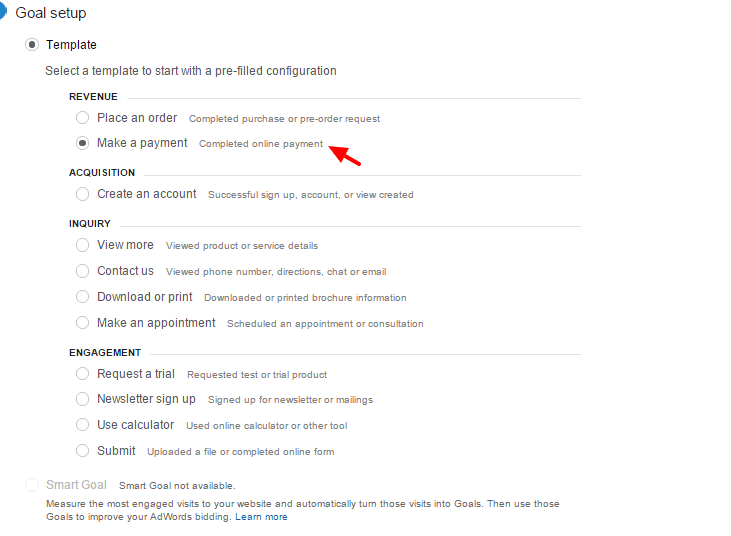
- Selecting Your Goal Type

Destination – It helps to track the visitors who reach a specific URL Destination or full route/path through the site (funnel). It can be HTML pages like thank you pages and confirmation screens that appear after landing pages downloads or sign-ups.
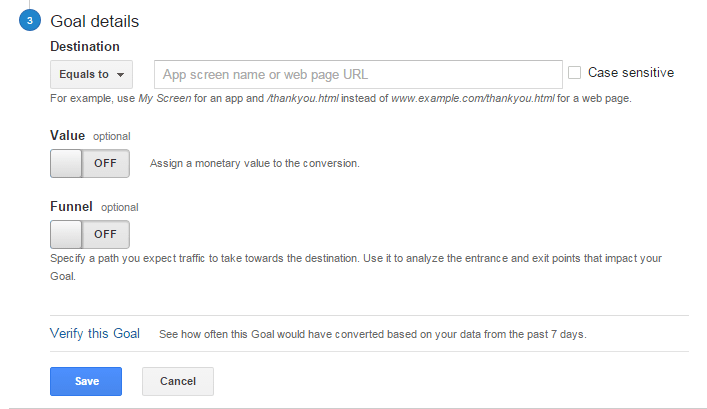
Duration – It helps to track the percentage of visitors who stay on the site for a specific amount of time (goal) which we would like users to spend on the website.
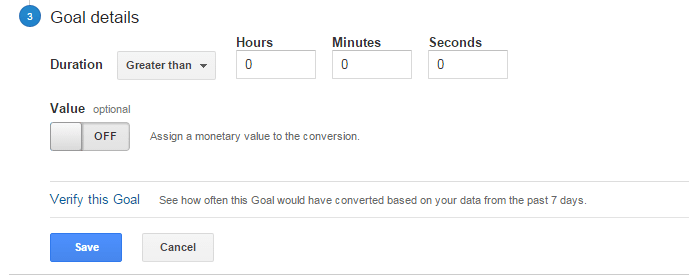
Pages/Screens – It helps to track the percentage of visitors who visit a specific amount of pages or screens per session. How many pages were viewed in a session is set as goal type.
Event – It helps to track specific interactions users make with your website content like when a user plays a video, clicks on an affiliate ad, leaves a comment on your blog or downloading a PDF. (To set up an Event Goal we first need to set up the user interaction as an Event using an Event Tracking code.)

For Example:
Choose ‘Destination’ as goal type and then click continue.
You will be taken to goal details screen where you have to give the URL which will be taken as destination page.

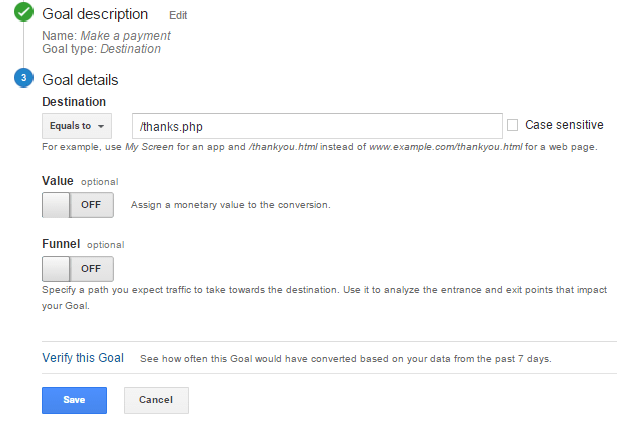

When a user makes a payment they will be landing on a ‘Thank you’ page which will be tracked as a conversion.
For Destination goals, we have a funnel option which can be defined if we need to track the sequence of pages you expect the visitor to navigate to reach the destination.
To setup funnel,
Turn ‘On’ the funnel option by clicking on it and add the page name and the URL. If you need to add more pages, click on ‘+ Add another step’.
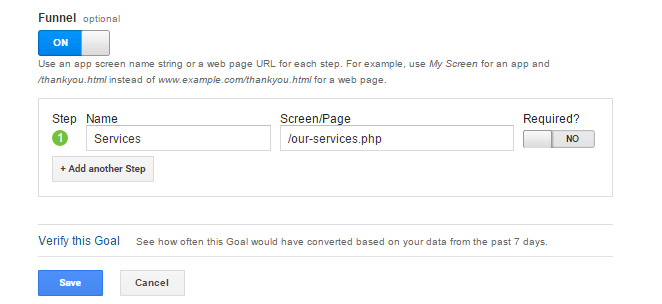
- Click on “Verify this Goal” and Save the Goal.
Monitoring Regularly
Once your goals are set, the next step is to track the goals which will give us the clear picture about what is bringing in business.
- Click on ‘Reporting’
 Click on Conversions -> Goals -> Overview
Click on Conversions -> Goals -> Overview
You will be able to view the number of goal completions, goal conversion rate, goal value and total abandonment rate. Regular tracking of your goals will definitely help us in building a strong digital marketing presence.
It’s Your Turn Now!
How have you implemented Goals in Google Analytics to track your business? How did goals help you in understanding your business in more refined manner? Do share your experience in evaluating your goals in the comments below.
if you haven’t got your Google Analytics Certificate from Google yet, here is an opportunity for you to learn how to get Google Analytics certificate for free.
This article was contributed by Akmela Priya, Digital Marketing Executive, echoVME under the guidance of Mr. Karthikeyan Maruthai, Digital Marketing Head at echoVME and Mr.Sorav Jain





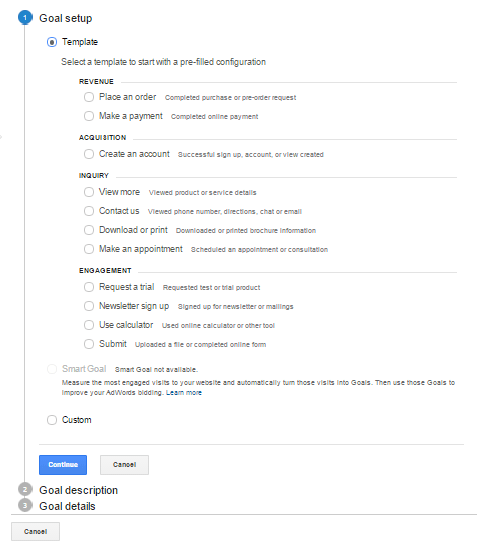
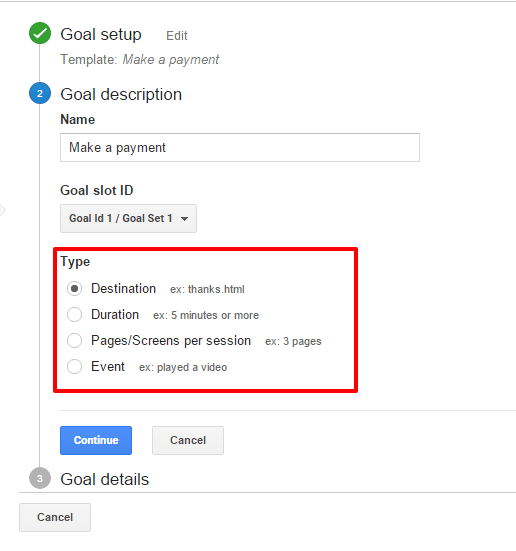

 Click on Conversions -> Goals -> Overview
Click on Conversions -> Goals -> Overview